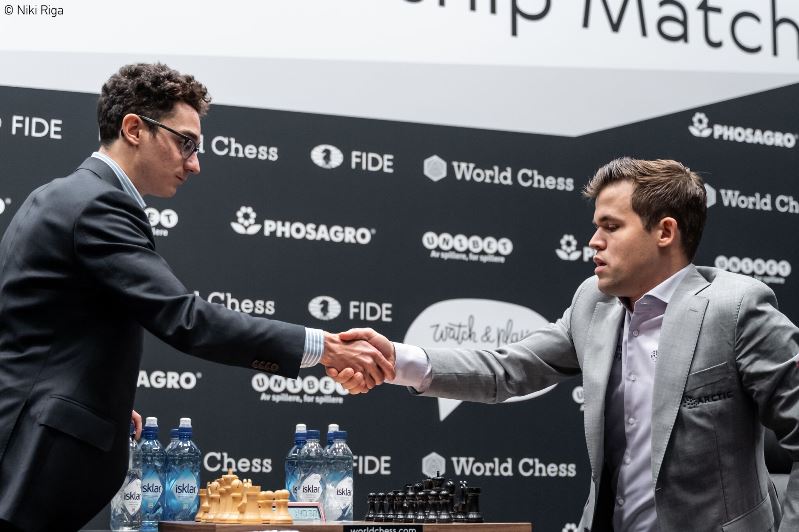Already in 2014, after the second Carlsen – Anand match, FIDE decided to hold the World Chess Championship as two-year cycles. After Carlsen defended his title against Karjakin, FIDE stuck to the same format. The regulations for the 2016-2018 cycle 1 envisioned staging of the Candidates Tournament in the first quarter of 2018 and the match itself in the last quarter of 2018.
The participants of the Candidates tournament were determined during 2017, as follows2:
- The loser of the World Chess CChampionship2016 (Sergey Karjakin)
- Top two finishers of the World Cup 2017 (Levon Aronian and Ding Liren)
- Top two finishers of the FIDE Grand Prix 2017 (Shakhriyar Mamedyarov and Wesley So)
- One wildcard nominated by Agon – the company who signed a contract with FIDE to organize official FIDE events, World Chess Championship included (Vladimir Kramnik) 3
The Candidates tournament was held in March 2018. Italian American 4 Fabiano Caruana seized the lead early and never let it slip. With an impressive performance, he won the tournament a clear point ahead of the Mamedyarov and Karjakin (9/14). The stage was set for the Carlsen – Caruana encounter.
The match was widely anticipated. In contrast to Carlsen’s previous matches where he was a clear favourite, this time everyone predicted a much closer fight. In the past, Caruana was one of the players who managed to pose Carlsen problems in the past. Indirect evidence was also provided by the players’ ratings before the match: 2835 for Carlsen and 2832 for Caruana. For the first time in a while, the participants in the World Championship Match were clear numbers one and two in the world.
The match was held in London, from 9-28 November 2018. The time control was 100 minutes for the first 40 moves, 50 minutes for the next 20 moves and 15 minutes for the rest of the game, with a 30-second increment per move from move 1. Colors alternated between games except after game 6, so the same player played with White in games 6 and 7. Draw agreements were not allowed before Black’s 30th move.
Already the first game was dramatic. After surprising his opponent with the Sveshnikov, Carlsen quickly obtained a superior position with the Black pieces. As he kept building the pressure, Caruana ran into time trouble and made several inaccuracies. Just as he was ready to reap the fruit of his instructive player, Carlsen missed several winning opportunities and had to settle for a draw.
After the initial excitement, the players managed to steady the waters. Good preparation with the Black pieces became a theme. In the games 2-5, neither player managed to achieve anything with the White pieces. Then in the game 6, Caruana even outplayed Magnus in a queenless middlegame, but missed a study-like win deep in the endgame.
The second half of the match saw players applying different strategies. Fully aware he would have an advantage in tiebreaks due to his superiority in rapid and blitz chess, Magnus decided not to risk to much with White. He tried to achieve a safe advantage, but failed to do so.
In contrast, due to his inferiority in speed chess, and due to the fact Magnus chose the Sicilian for this match, Caruana’s subsequent White games were fighting and complicated. In the game eight, he managed to surprise Magnus with the rare 7 Nd5!? in the Sveshnikov. For the first time in the match, Caruana obtained a serious advantage, but one inaccurate move blew it away at once.
Game ten featured the same Nd5 variation. Once again Caruana was the first to employ a novelty. Magnus reacted well and obtained a double-edged position in which both sides had their chances. Although exhaustive analysis of this game will be featured in many books, at first glance it seems that the evaluation was always within the dynamic equilibrium.
Finally, in the 12th game, Carlsen was the first to deviate and gained an overwhelming position. However, due to his nervous state and eagerness to reach tiebreak5, he avoided the critical continuation and then, to the surprise of the whole chess world – offered a draw. Thus, the players set a negative record – for the first time in history, all games of a World Championship match were drawn. 6
Although Carlsen was severely criticized for his decision in the final game, the course of the tiebreak shown it was justified. Just like against Karjakin, he completely dominated and swept the challenger with a clear 3-0 victory. Almost three weeks of struggle in classical chess were resolved in the span of a few hours.
Even though the result led to endless debates about the tiebreak format, 7 there was no denying that Carlsen’s victory was well-deserved. For the fourth time in five years, he defended his crown and extended his legacy for at least two additional years.
Check our coverage of Candidates tournament 2018 here
Check our coverage of the Carlsen – Caruana match here
Featured image credit: Niki Riga
- Rules & regulations for the Candidates Tournament of the FIDE World Championship cycle 2016-2018
- Source: Chessgames – Candidates Tournament 2018
- You might recall this agreement caused a lot of controversies because Agon tried to prevent other chess companies from broadcasting the moves at their events.
- American Italian?
- The stakes were high!
- Much to the delight of chess haters, who were happy to chastise the players for such a result and yearn for the giants from the past.
- Which also includes the author of this post – we have expressed our opinion on the current format in great detail during our coverage of both Carlsen – Karjakin and Carlsen – Caruana Matches.


